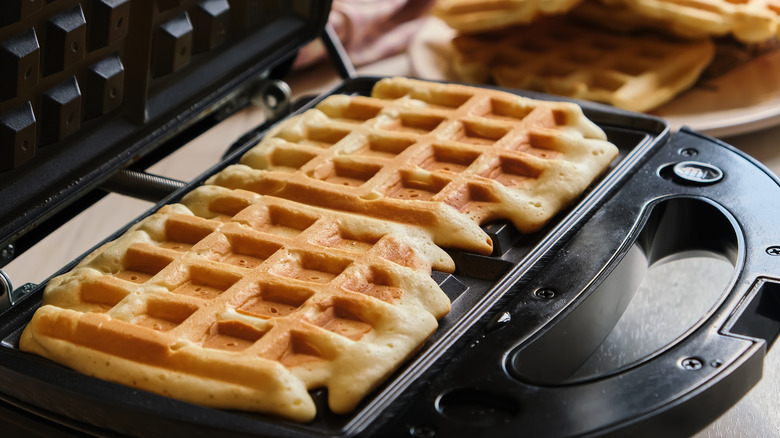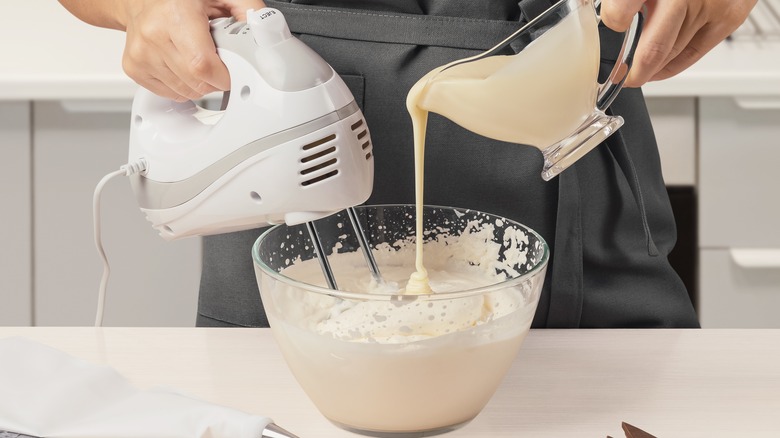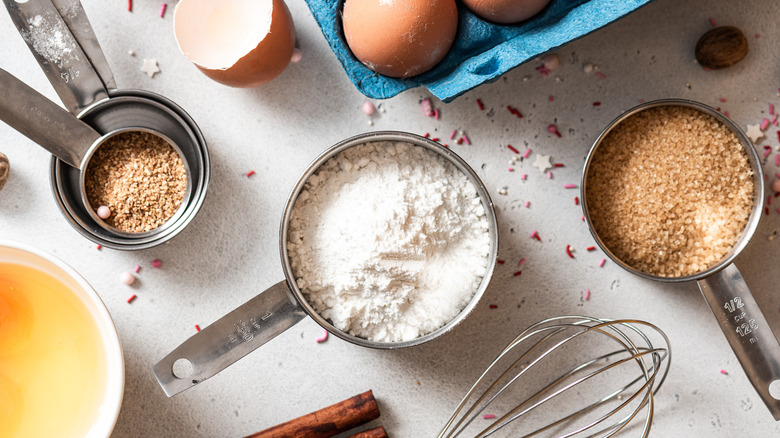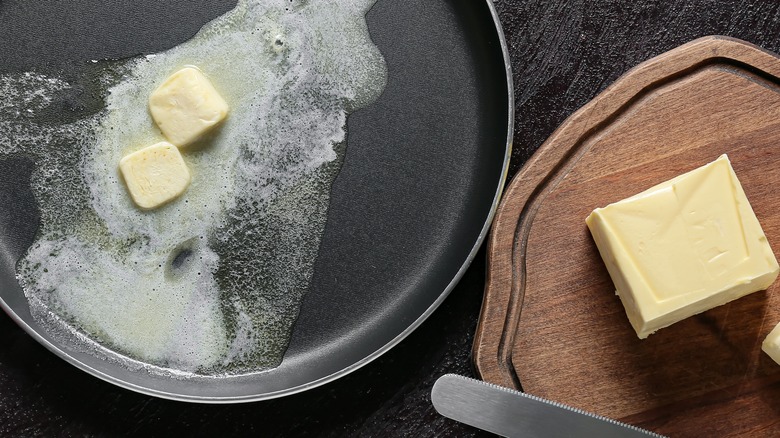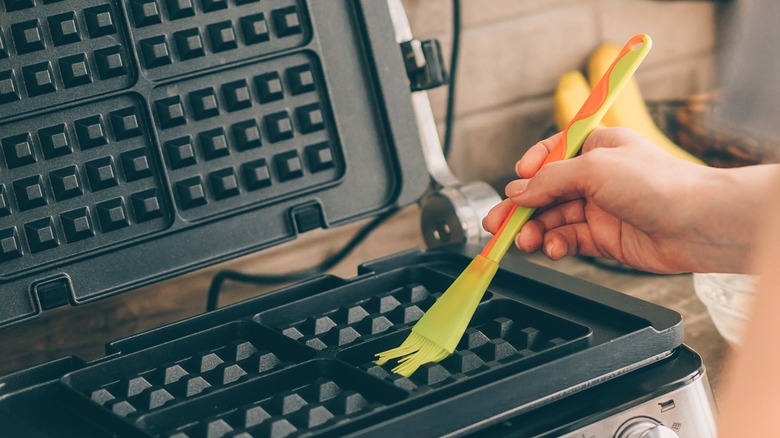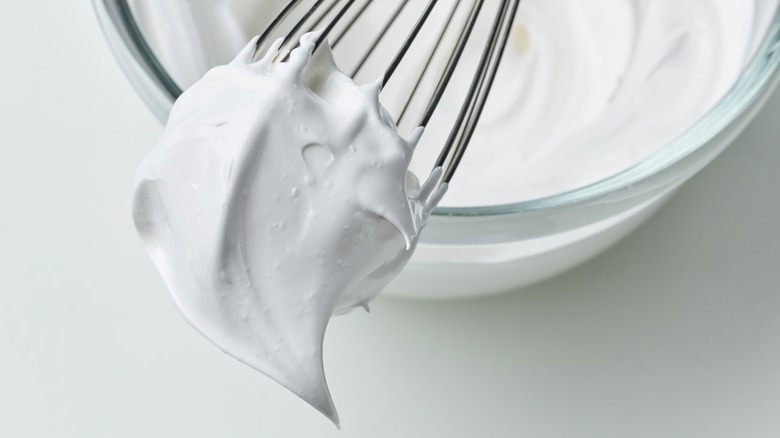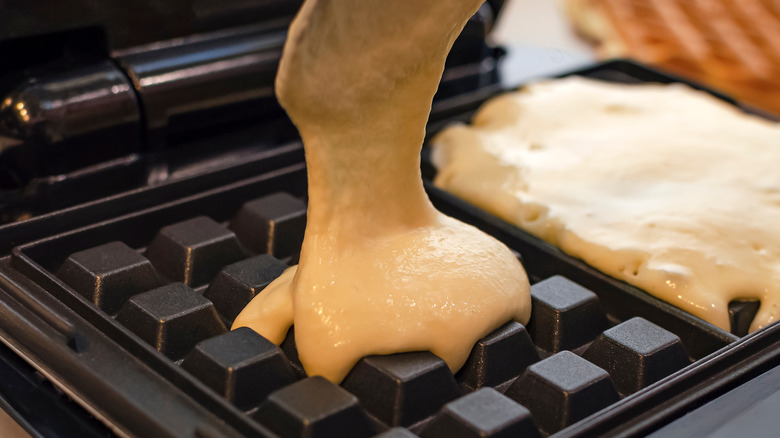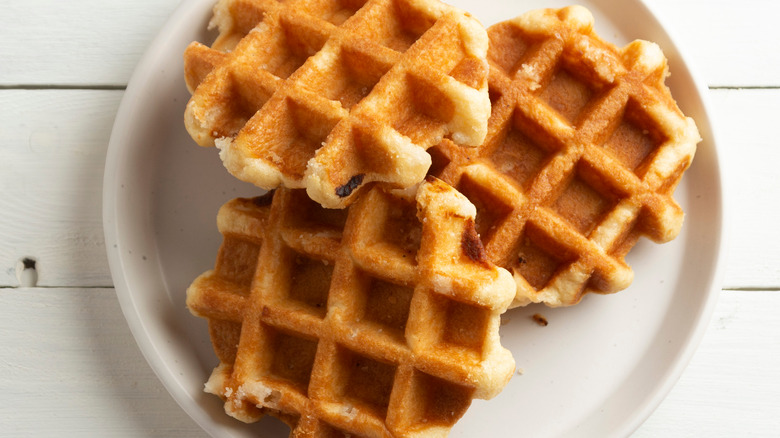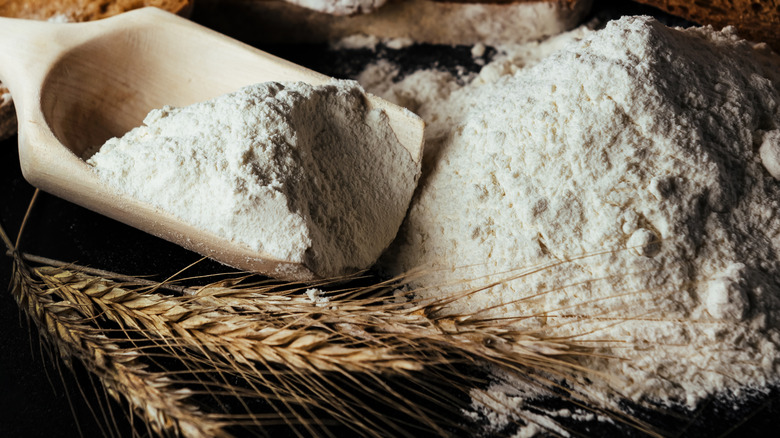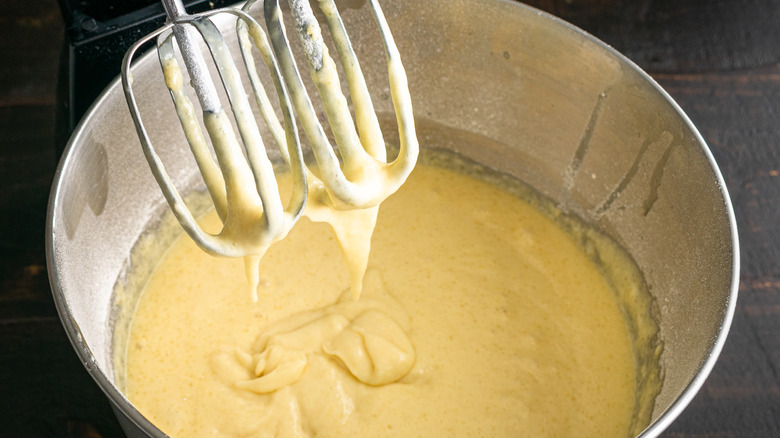Mistakes Everyone Makes With Homemade Waffles
The waffle is essentially the pancake's more elevated, textured, and nuanced cousin. While there's nothing wrong with buying a box of frozen waffles and popping those in the toaster, or going out and paying (roughly) a billion dollars for waffles at some fancy brunch spot, there is something so satisfying about making waffles in the comfort of your own home. Yes, waffles require a very specific piece of cooking equipment (although, good news, you can in fact use a waffle iron for other things), but we promise you, the effort is worth it.
However, waffles are deceptively tricky. At first glance they're just a simple batter poured onto a hot, patterned iron, and griddled til done. But in reality, achieving that utterly crispy on the outside, tall, light, and fluffy on the inside waffle requires a bit of thought, prep, and, sorry to say, an understanding of the science of baking. Somewhere your high school chemistry teacher is laughing maniacally. But don't despair! We've rounded up a list of some of the most common waffle-makin' mistakes home bakers can make so that you wind up with nothing but perfection on your brunch plate.
Letting the batter sit too long
Yes, we can see how this "mistake" is bound to happen when you're making waffles at home: You mix your batter ingredients together, and then suddenly your toddler and/or hungover roommate has knocked over the maple syrup, and it's a while before the batter makes its way to the waffle iron. It happens. But if you can, it's best to start cooking up your waffles as soon as you mix the batter together.
The reason, according to The Food Network, is that many waffle recipes contain baking soda, which activates as soon as it's mixed with the wet ingredients, releasing little gas bubbles that help your waffles rise and get nice and fluffy. So if you let your batter sit, all that precious gas escapes, and you'll be left with flat waffles. It should be noted that this "don't let it sit rule" goes out the window if you're making waffles with yeast or sourdough starter (via Epicurious). In that case, you want the batter to sit for as long as possible to allow for fermentation, which acts as the rising agents in these crisp, tall, fluffy waffles. That ties into our next point ...
Not reading the recipe closely enough
The most crucial mistake you can make when whipping up your own waffles is to not read the recipe closely. This seems obvious, but be honest: How many times have you gone to make a recipe only to realize it requires a lot more time and ingredients than you thought? The main reason this is important when making waffles is because they can have different rising agents that require very different timelines.
If you want to give yeasted waffles a try, this Epicurious recipe is highly rated. But if you don't read carefully, you'll almost miss that step three is basically telling you to add the yeast and wait around a while. This is hard to do when you've got a bunch of friends coming over in 20 minutes expecting brunch. On the other hand, this Tasting Table recipe uses baking soda, which we now know would be borderline disastrous if you didn't throw the batter on the hot iron as soon as it's mixed. You also never know when a recipe is going to call for a specific kind of ingredient like buttermilk, which you might not have sitting around in your fridge.
Not adding your own flavors
Now we're going to (almost) immediately contradict ourselves and say: Don't make the mistake of following your waffle recipe too closely. No, we're not speaking in riddles here, we promise. But the truth is, waffles don't need to be boring. They're the perfect blank slate for a whole host of flavors. So go ahead and get creative!
It's super easy to sub in some flavors either in the dry or wet ingredients. King Arthur Baking Company recommends adding some cinnamon or vanilla extract to up the ante, or even some lemon oil and fresh berries for a more summery waffle. You can mix in a little pumpkin puree and pumpkin pie spices like nutmeg, cardamom, or ginger if you're fully embracing that Pumpkin Spice Latte life. And don't forget to try different flours! This waffle recipe swaps in some mochiko flour, which is made from sweet rice and gives waffles a delicious, chewy, almost custard-like texture. Have fun experimenting with your own favorite flavors and mix-ins!
Using cold ingredients
Here's a mistake that many of us have likely made over and over again when making waffles or pancakes: not warming our liquid ingredients. Yes, warming ingredients, or just remembering to take them out of the refrigerator so they can get to room temperature, means extra work and planning ahead, which may not sound super appealing in the wee hours of the morning when most of us make waffles. But according to King Arthur Baking Company, the extra step will be well worth it.
First of all, a lot of waffle recipes call for melted butter, but when you add that warmed butter into cold milk or buttermilk, it will cause the butter to harden, and then you're left with little butter chunks in your batter. Not ideal. Secondly, warm or room-temperature liquid ingredients blend together better and easier, which means you'll be less likely to overmix your batter, another waffle no-no we'll get to in a second. Basically, this small extra step means better waffles.
Not greasing your waffle iron enough
Nothing is more devastating than when you lovingly warm the wet ingredients for your waffle batter, then let them sit overnight, only for the waffle to get totally destroyed by sticking to the darn waffle iron. There are so many types of waffle makers out there that boast a non-stick coating to prevent such a tragedy. But heed our warning: DO NOT TRUST THEM. You're gonna want to grease up your waffle maker real good. If you're dubious, know that the waffle makers over at the iconic Waffle House also do this!
The fun of greasing the iron is you can also use your grease of choice, be it vegetable oil or something more delicious like butter. Although, famous waffle chef Chris Bradley of Phoenicia Diner fame warns that butter can burn pretty quickly and recommends classic cooking spray (via Epicurious). The bakers over at King Arthur Baking Company suggest using a basting brush to really get in every corner of that waffle iron. And over at Love Food, they point out that not only does the fat in the waffle batter help, but really greasing your waffle iron will help produce a more crispy outside as the batter essentially fries in the fat. Yum!
Not whipping the egg whites separately
So far it might seem like this list is just telling you that making waffles needs to be difficult. First we want you to melt the butter and heat the milk, now we want you to whip the egg whites separately? The answer is yes, but it's only because we want you to have the best waffles ever. Separating the eggs then whipping the egg whites into soft peaks is going to improve your life. Or at least your waffles.
Put simply, whipped egg whites make for a lighter batter. And a lighter, more airy batter makes for lighter, more airy waffles (via King Arthur Baking Company). But don't just trust us. The Egg Farmers of Canada also agree that the protein in egg whites is ideal for stretching and trapping air bubbles needed to fluff up your waffles. Just make sure to cook the batter quickly so that all that incorporated air doesn't deflate. (But you already knew this trick, didn't you?)
Lifting the waffle iron lid too soon
So you went ahead and bought a nice waffle iron that comes with a light that tells you when your waffle is done cooking. We're living in the future! Artificial intelligence is cooking our breakfast for us! But we're here to tell you the waffle robots cannot be trusted. That's right. You must ignore that red light because it will lead you astray. According to King Arthur Baking Company, there is but one guide to follow when cooking waffles, and that is steam. Good, old fashion, non-robotic steam. Your waffle is not done cooking until every last wisp of steam has stopped rising from that iron. Then, and only then, may you open the lid.
According to Epicurious, you want to let your waffle iron heat up for at least 10 minutes before you pour on the batter, despite what the little "ready" light might be telling you. This ensures that the waffle iron is hot enough to give your waffles that crispy outside. And ideally, you should give your iron time to reheat between each waffle.
Letting your waffles get cold
The problem with making waffles for a crowd is that they have to be cooked one at a time, which means the waffles can be cold by the time everyone is ready to eat. But serving your perfectly cooked, crispy yet fluffy waffles cold is akin to serving ice cream warm; it simply cannot happen. You want everyone's waffles nice, warm, and still crispy when they hit the table. But how do you do that?
Luckily, America's Test Kitchen has the answer. Set your oven to 200 degrees, and place a wire cooling rack inside a baking sheet. That's where you'll drop each waffle as it comes off the waffle iron. The raised nature of the rack in the warm oven will keep your fresh waffles uniformly warm and crisp without overcooking them. And if you really want to kick it up a notch, serve the maple syrup warm and the butter at room temperature for easy spreadability (via King Arthur Baking Company).
Using sub-par ingredients
When attempting any recipe, there's a simple fact that your dish is only as good as the ingredients that go into it. If you use sub-par ingredients, you're going to wind up with sub-par waffles (via Love Food). Using non-expired, high-quality all purpose flour, eggs, and buttermilk are going to really make a difference. If you can swing it, fresh spices will provide more flavor, if you're going the flavored route. This doesn't mean there's only one "right" way to make waffles; you can still experiment with ingredients. Whether you want to make mochi waffles, chickpea waffles, vegan waffles, or just classic Belgian waffles, just be sure you're doing it with the best, freshest ingredients you can.
Now, of course, cost can be a factor. Using organic or free-range eggs will taste better, but they also typically cost more. We all want to use fancy butter like Martha Stewart, but most of us don't live on horse farms. Don't stress about using the finest ingredients. Just make sure they're fresh.
Overmixing your batter
"Don't overmix the batter" is one of those frustratingly vague baking instructions that we see so often. So, yes, it's annoying that we're also telling you not to overmix your waffle batter, but allow us to clarify what this means. The problem with overmixing your batter is that you can over-aerate the batter, which can cause your waffles to collapse and flatten when they cook (via Food52). But more importantly for waffles, you can overwork the gluten in the flour, which can lead to dense, overly chewy waffles.
Luckily, there is an easy way to avoid the mysterious "overmixed batter" syndrome, and that is to simply fold your wet and dry ingredients together. This means combining the ingredients, and then rather than whisking or stirring vigorously, you take a spatula or wooden spoon and scrape a line down the middle, then fold the ingredients on top of each other slowly and carefully until everything is just combined. If you are a visual learner, here's a YouTube video from Food52 to demonstrate the process. Rest assured, it's very easy!
